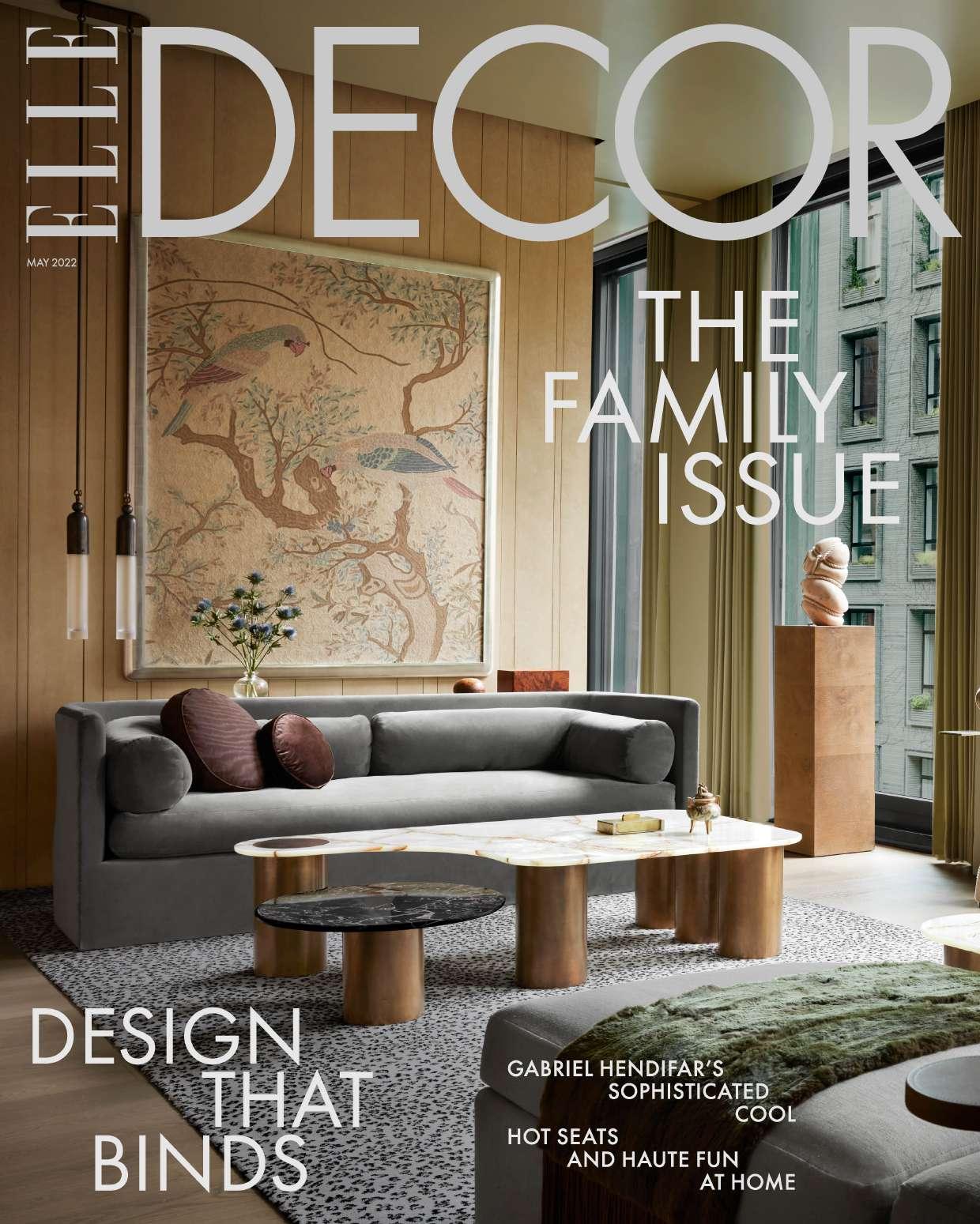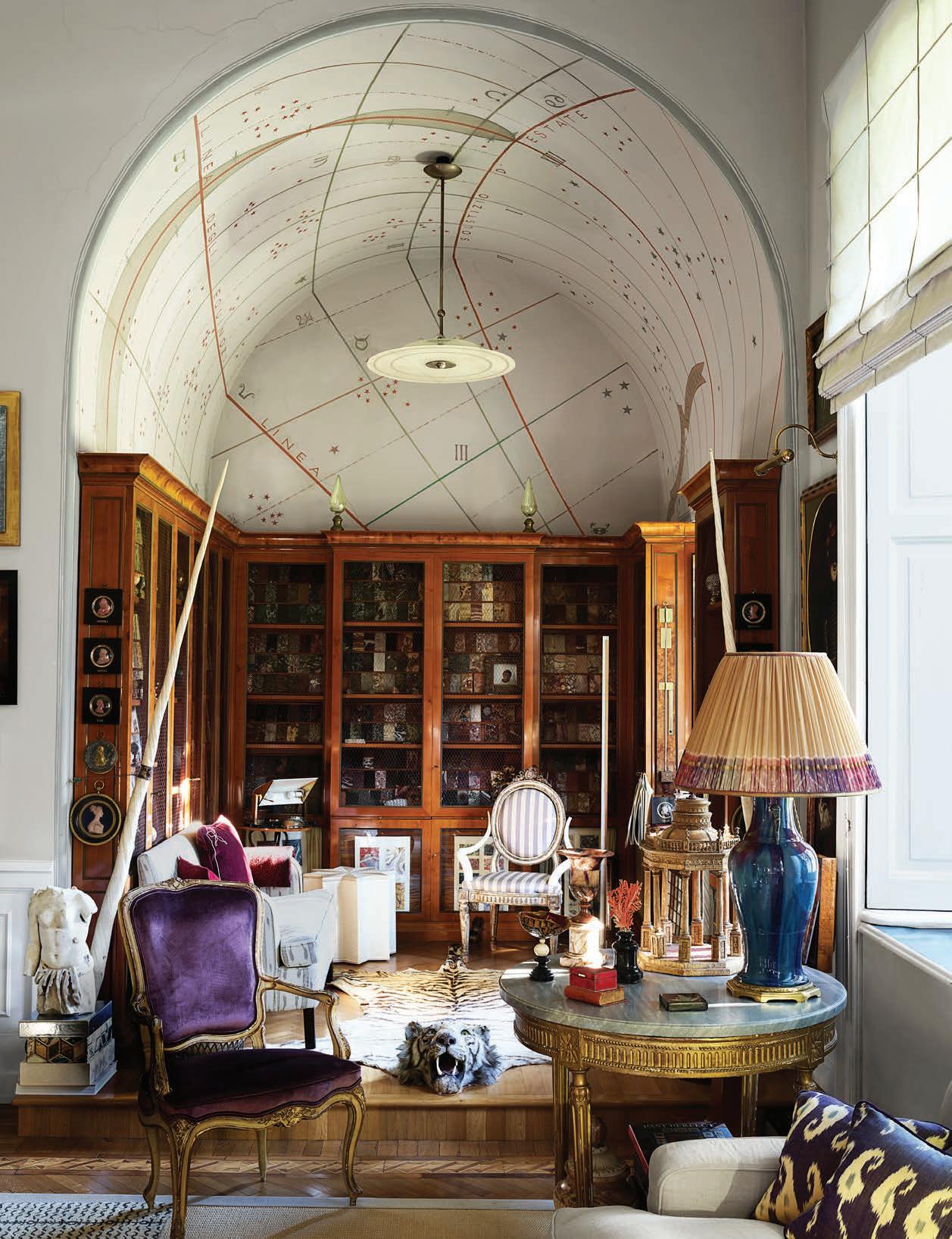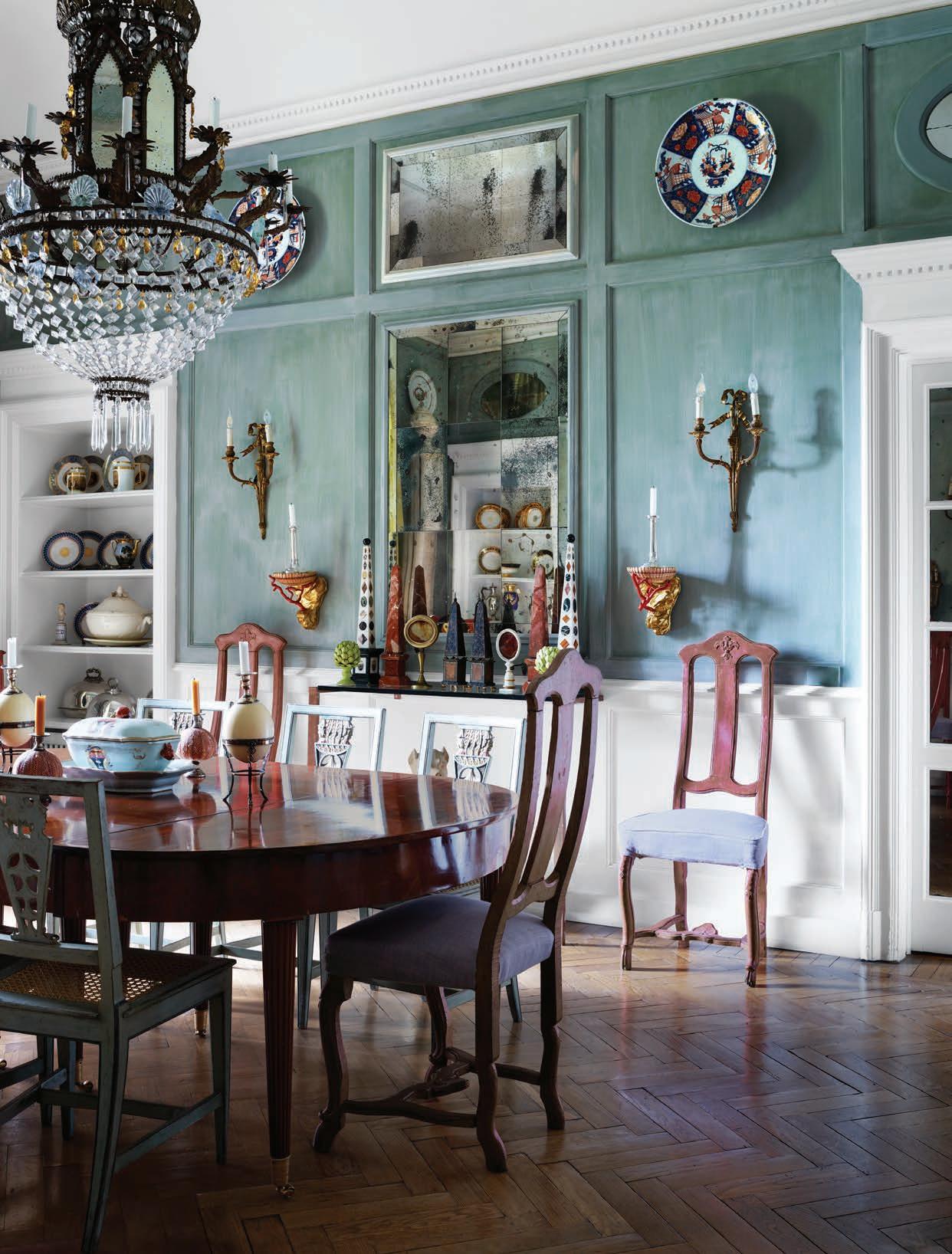

IT’S ALL
The interior courtyard of Milan’s Casa degli Atellani, the Castellini family compound. The palazzo was renovated in 1919 and after World War II by architect Piero Portaluppi, and most recently by his grandson, architect Piero Castellini Baldissera, who lives in his grandfather’s former home on the property.

For details, see Resources.
RELATIVE
In the center of Milan, the city’s quintessential design clan shares a centuries-old palazzo renovated by their forebear, the legendary architect Piero Portaluppi.
In Castellini Baldissera’s private apartment, a living room alcove is lined with mesh-fronted wooden shelves holding a rare col lection of antique marble, including some pieces from ancient Rome, and the ceiling is decorated with a working sundial designed by Portaluppi.

T
he first time I met Piero Castellini Baldissera was at his home in Casa degli Atellani in the center of Milan. Nicolò Castellini Baldissera, his son and my partner, hadn’t provided much forewarning about his family palazzo—about its likely connection to Leonardo da Vinci while he was painting the Last Supper at Santa Maria delle Grazie church across the street, or about the attached apartment building filled with members of his extended family, or even about the museum and café run by his cousin in the middle of the compound’s courtyard.
When Piero’s ancestor Ettore Conti purchased the 15th-century palace in 1919, he enlisted the help of the legendary architect Piero Portaluppi (the husband of Conti’s niece Lia Baglia, whom he later adopted) to restore it. He engaged him a second time to repair the complex following damage incurred from shelling during World War II. Portaluppi reimagined the crumbling Renaissance architecture in the neoclassical style while incorporat ing such 20th-century Milanese references as geometric mosaic floors and an elaborate butterfly window.
The afternoon we visited, the courtyard was buzzing with activity. “Ciao, Nicolò!” called his aunt, Letizia Castellini Baldissera, who has her own apartment here and who came over to let us know about an event that evening. “Dior rented the garden for dinner; the table stretches all the way down to the vineyard. By the way, have you seen your cousin?” she asked as we started to go. “No, but I’m sure we will,” Nicolò responded.
Even in Italy, where children (especially boys) sometimes choose to live at home well into their 30s, it is unusual to have such a concentration of family all living and working together. “How many are you?” I overheard someone ask at a party. “We came from many, and now we are more,” was the response.
In his nearly six-decade-long career, beginning in 1911, Portaluppi helped define modern architecture in Italy. His magnum opus, Villa Necchi Campiglio, was a revolutionary work of Art Deco set in a private garden in the center of Milan. His unique style can be seen all over the city and beyond—from his civic planetarium to the Piedmont power plants he designed for Conti’s electric company.
Portaluppi’s house—the section where his grandson Piero Castellini Baldissera now lives with his partner, Paola Reggiori—sits within the courtyard of Casa degli
Atellani and looks out over the garden. It is the most eccentric section of the property, with verdant frescoes in the entryway and a working sundial painted on the ceiling. While Portaluppi preferred a restrained decora tive style, Piero—himself a renowned architect and interior designer—has filled the apartment with collec tions of coral branches, contemporary art, books, and anything that sparks his unrestrained curiosity. He has also added his own touches, such as the trompe l’oeil door he tucked under an arcade in the courtyard.
Portaluppi’s influence is ever present: His former workplace, around the corner from Casa degli Atellani in his 1939 Casa Portaluppi building, is now a foundation and also holds the offices of the architectural firm Piero runs and collaborates on with Nicolò.
The palazzo and nearby buildings serve as a home base to any number of businesses owned by this family that lives and breathes design. When Piero and his cousin Emanuele Castellini started their luxury fabric brand C&C Milano in 1996, they worked out the details in the palazzo’s communal dining room. Piero brought with him a history of design and style, while Emanuele had mana gerial experience from running the family’s former tex tile factory. Meanwhile, a discovery of grapevine roots in the courtyard was traced to Leonardo da Vinci’s 16thcentury vineyard here; a matching vine was found in Emilia-Romagna, replanted, and first harvested in 2018.
In a memorable opening scene from Luca Guadagnino’s 2009 cult film I Am Love, Piero himself toasts the fictional Recchi family, who in the movie cele brates the passing of the torch from one generation of fabric producers to the next. It was a bit part, the kind a producer might give to a friend, or an in-law, but in Milan the casting spoke volumes: a nod by the director to the world his characters inhabited and the type of family to which they belonged. Throughout the movie more clues are dropped—Tilda Swinton, in the role of the Recchi family matriarch, sports a C&C Milano bag, for instance—to show that the visual vocabulary and enterprising spirit of the film’s Recchi family owes a great deal to Milan’s Castellini clan.
The movie was largely shot at Villa Necchi Campiglio, which was restored by Piero shortly before filming began, as well as in his own apartment at Casa degli Atellani. In scene after scene, we see C&C’s stripes and chevrons, in the creamy colors and linens that are characteristic of the brand. A decade later, the company’s success has led to an expansion, with showrooms in New York, Paris, and London. Both Nicolò and his cousin, the fashion designer Gigliola Castellini Curiel, have been enlisted to help out. For the Castellinis, the design conversation continues across the generations.
In the dining room of Castellini Baldissera’s house, 17th-century Italian chairs surround an 18th-century French mahogany table. Seventeenthcentury Sicilian chandelier; palegreen boiserie walls.

OPPOSITE, CLOCKWISE FROM TOP: In the entry, the garden frescoes and Venetian-style semi nato mosaic floor were designed in 1930 by Portaluppi. The Louis XVI canopy bed in Castellini

Baldissera’s bedroom is dressed in a quilt from the fabric firm he co-owns, C&C Milano. A guest room features twin Louis XVI headboards, and bed c overs in a Braquenié toile de Jouy.


The family gathers in the boiserie-paneled draw ing room in a communal section of the house, the former living quarters of Count Ettore Conti.
From left: Nicolò Castellini Baldissera, Letizia Castellini Baldissera, Gigliola Castellini Curiel, Piero Castellini Baldissera, and Emanuele Castellini.

In a meeting room at the Portaluppi Foundation, the floor is made of various marble tiles that the architect used as options to show clients.
RIGHT: Castellini Baldissera’s architec ture studio, also in Casa Portaluppi. On display are 17th-century models of an altar and a church.

OPPOSITE, TOP: An omnibus mapleand-briar desk with rotating drawers at the Portaluppi Foundation.

In the entrance of Casa Portaluppi, the renowned architect’s descendants (from left), Filippo Taidelli, Piero Castellini Baldissera, and Nicolò Castellini Baldissera.


